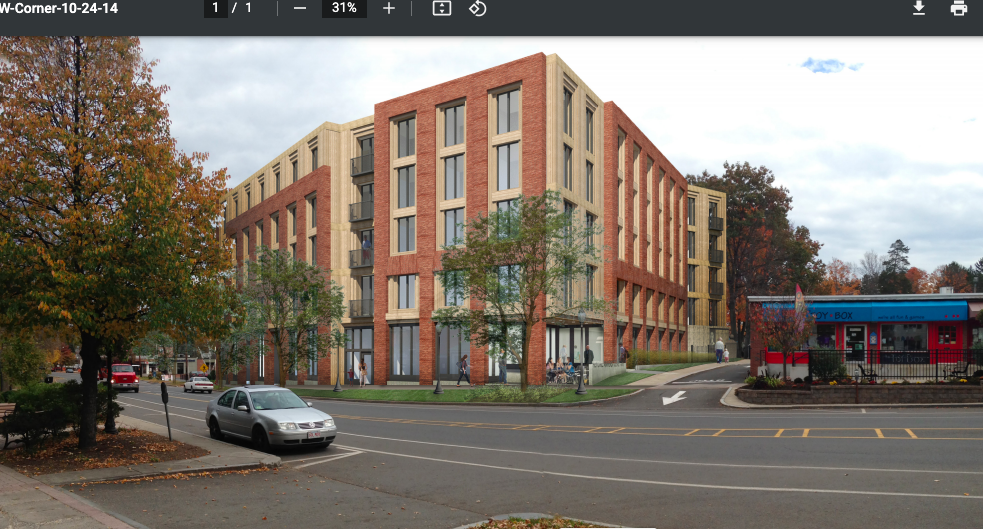Opinion: Expecting Residential Neighborhoods To Host Students Is A Big Ask

One East Pleasant Street. Photo: amherstma.gov

Early in the twentieth century, the Boston metro area needed more water. As a result, 4 small towns in the center of the state were taken by eminent domain, the residents compensated, the Swift River valley was dammed and flooded, and the Quabbin reservoir came into being.
A century later, the state again realized it had another burgeoning need. To meet the rising educational demands of the tech-oriented state, the state decided to increase the size of the UMass campus in Amherst. It sought to make this laudable goal more affordable by skipping building dorms for additional students. This effectively outsourced the problem of housing students to Amherst and its surrounding towns. Conveniently, it coincided with the national rise of wealthy investors, private and corporate, who sought to profit by specializing in student housing. (There are now entire websites devoted to preaching this get rich quick scheme of converting single family homes to student rentals.)
This has resulted in a flood of a different sort inundating the Amherst area. Businesses are being swept away by multi-story apartments. Students are now spilling over into what were once peaceful, stable neighborhoods. This is enriching investors while it is eroding the culture of the town and decreasing the peace of mind and property values of residents who are finding themselves unexpectedly abutting houses crammed with students. In the past decade alone, the town has seen more than 200 single family homes converted to student housing, and the permanent resident population drop by nearly 10%. Ongoing projects like a multimillion-dollar library renovation and a new elementary school, predicated on the needs of families now fleeing town, seem increasingly questionable, even without substantial cost over-runs. The permanent resident population has dipped below the student population (a fairly unique situation nation-wide, and one that stifles comparing the percentage of students UMass houses to other major universities), putting a strain on town resources. Among corollary pearls of wisdom: Don’t have a heart attack in Amherst on Friday or Saturday nights, because all available ambulances are ferrying drunk or injured students to the hospital 10 miles away. The town, which used to pride itself on being an intellectually stimulating, progressive, semi-rural community is en route to becoming just a food court / bar / apartment complex for UMass students, with a PC nod toward ‘affordable’ housing, and a few toney enclaves at the margins.
There was no compensation offered, no eminent domain declared, to clear out town residents. Displacement is happening because investors are outbidding single families seeking to enter the housing market, and student partying in decaying rental housing stock impels middle-class families to move from their homes. Town management seems focused on balancing the budget, and courting investors. There is little interest in, or ability to, enforce the zoning and behavioral rules already on the books, let alone expand protections for increasingly anxious residents. The University is now playing catch-up. Unfortunately, it has been shifting its housing problems to the community for years, town management is doing almost nothing, and the ’free market’ has responded with a feeding frenzy of investment in off campus student housing that is unraveling the social fabric of the town. Mending this, if possible at all, is a multi-year project.
UMass, by virtue of its size, gets plenty of de facto representation in town, and uses the town infrastructure, but its efforts at amelioration have been relatively anemic. the University and its land – half the town’s area – is exempt from local taxation. Through the inattention or indifference of the University and its trustees to the town’s needs and regulations, it has gone from being the life blood of Amherst to draining the life blood from it.
There Are Solutions
There are solutions. Many communities have dealt with the problems of student housing for decades, and Amherst could benefit by simply cutting and pasting solutions that have proven successful. Elsewhere, communities have recognized student housing as a business, a separate category of real estate to be tracked and regulated differently from non-student rentals. Communities have established systems to allocate points for infractions of behavioral and building codes – systems that include hefty fines and pulling rental permits for unruly tenants and scofflaw landlords. They have established minimum distances between student rentals. And communities are coming up with the personnel and resources to enforce their laws.
Thankfully, UMass is stepping up with new housing construction for grad students with families. It also needs to increase the funding of dormitories, and/or expand public/private partnerships to erect student apartments on university land. It needs to streamline and enforce its disciplinary policies regulating off-campus housing. And it needs to recognize that new faculty coming to Amherst are now having trouble finding and affording housing because of the area’s housing crisis, for which it is at least partially responsible.
People who do not recognize there is a problem need to ask themselves: Would you, as an adult, like to live next to the twenty-year-old you? Kids go away to college in part to learn how to live as adults. It is often a noisy, messy, inebriated, nocturnal process, best pursued away from families with small children and work schedules. Most students are well behaved, most of the time. But how many times a year is a reasonable limit for being awakened by drunken revelry next door? How much trash in the front yard is too much? How many cars parked on the lawn are too many and how much extra traffic is unsafe? How far below community repair and maintenance standards does a student rental have to be before it sullies a neighborhood? College students have different schedules and social needs than adults, with or without families. Expecting residential neighborhoods to host students is a big ask. It is made more onerous and painful when coupled to investors seeking to get rich while blithely degrading the lives of those who abut the properties they buy via lax maintenance and tenants’ ‘normal’ college partying.
There are markers and monuments commemorating the 4 towns drowned to make the Quabbin. Amherst residents do not want a monument. They do not want to be displaced, with or without recompense from the state. They want UMass, its trustees and Amherst town management to recognize there is a problem, to be responsible and diligent, and to be fair. They want solutions to a problem that threatens to submerge them beneath a sea of students.
John Varner lives in Amherst.

Well put John! Often some forget that this is not just a quality of life issue, but a housing affordability, racial justice, economic, public safety and environmental issue as well. To be a truly welcoming university, UMASS must recognize that and take steps towards a thoughtful, intersectional resolution.
This is poignant and extremely accurate. Single family dwelling owners are virtually ignored, and every week the Jones Library addition is showing approved new amounts for their project. Amherst single family dwelling percentage amounts are drastically way below town percentages recommended by Massachusetts guidelines, yet nothing is going the way of halting this. To town officials these are just numbers, that they ignore. Big money projects get their attention, not the homeowners paying high taxes to the town. This is pretty sickening for these homeowners to read about, with no end in sight to their dilemma, and nothing left to do except sell their property. This is not the way we’re supposed to be treated.
Personally, I’m really “up to here” with Amherst’s governing process. It used to be one of the best places to live and raise a family, but that town has been gone for a long time.